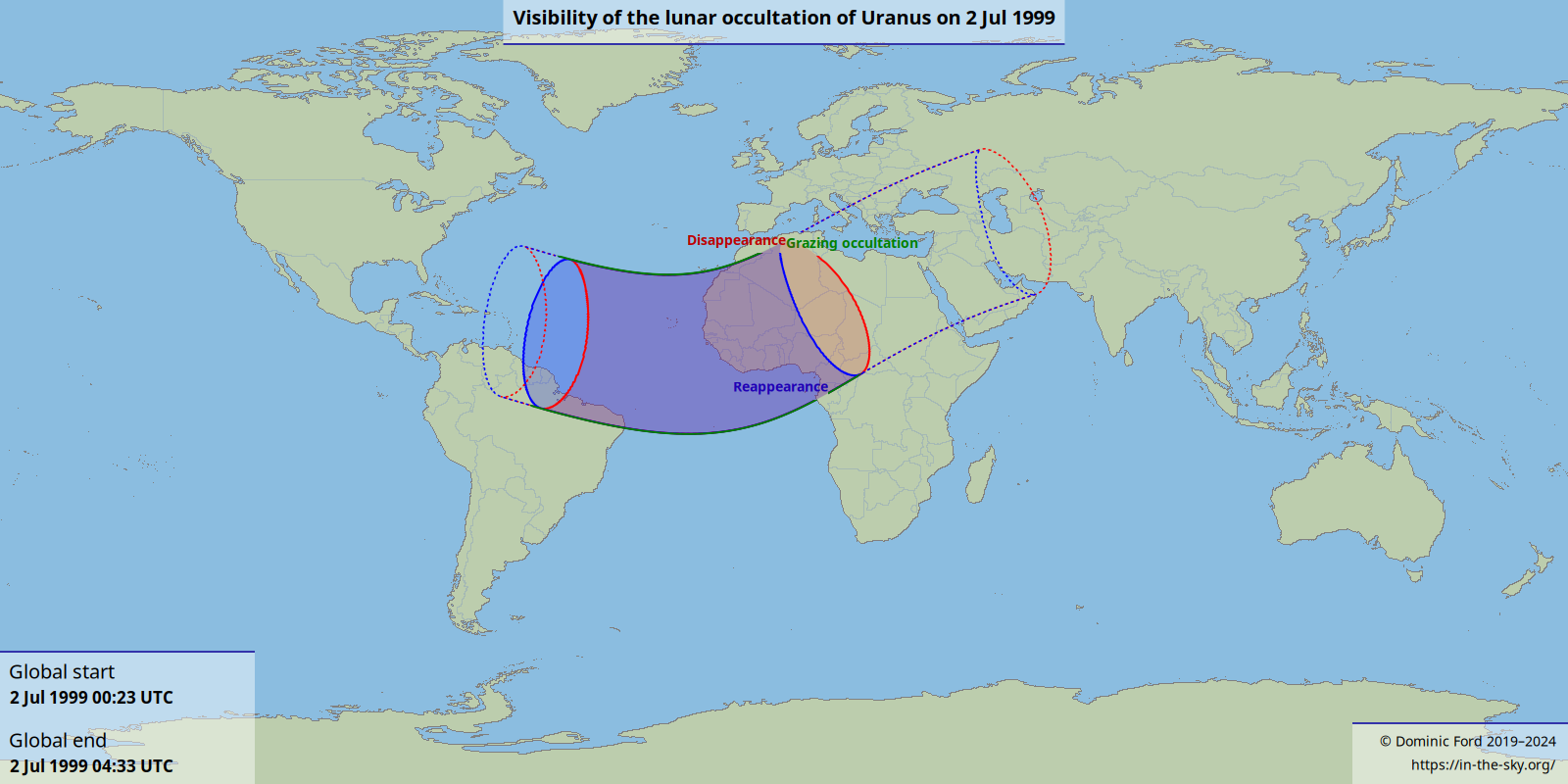The Moon will pass in front of Uranus, creating a lunar occultation visible from parts of Africa and South America. Although the occultation will only be visible across part of the world – because the Moon is so close to the Earth that its position in the sky varies by as much as two degrees across the world – a close conjunction between the pair will be more widely visible.
Unfortunately the occultation will not be visible from South El Monte.
The map below shows the visibility of the occultation across the world. Separate contours show where the disappearance of Uranus is visible (shown in red), and where its reappearance is visible (shown in blue). Solid contours show where each event is likely to be visible through binoculars at a reasonable altitude in the sky. Dotted contours indicate where each event occurs above the horizon, but may not be visible due to the sky being too bright or the Moon being very close to the horizon.

Outside the contours, the Moon will not pass in front of Uranus at any time, or is below the horizon at the time of the occultation. However, a close conjunction between the pair will be visible across much of the world.
The map can be downloaded in PNG , PDF or SVG format. A KMZ file , is also available, which can be opened in Google Earth to provide a higher resolution map.
The animation below shows the path of the occultation across the Earth's globe. The red circle shows where the Moon appears in front of Uranus.
A complete list of the countries and territories where the occultation will be visible is as follows:
| Country | Time span (UTC) |
| Algeria | 02:06–04:04 |
| Brazil | 00:24–01:38 |
| Mali | 01:19–03:46 |
| Niger | 01:55–04:11 |
| Mauritania | 01:16–03:18 |
| Nigeria | 01:57–04:01 |
| Chad | 02:34–04:12 |
| Cameroon | 02:19–04:01 |
| Ivory Coast | 01:21–03:22 |
| Western Sahara | 01:27–02:57 |
| Burkina Faso | 01:33–03:38 |
| Central African Republic | 02:42–03:56 |
| Guinea | 01:08–03:07 |
| Ghana | 01:37–03:31 |
| Senegal | 01:07–02:58 |
| Guyana | 00:24–01:21 |
| Morocco | 02:08–03:08 |
| Libya | 02:35–04:09 |
| Suriname | 00:24–01:22 |
| Gabon | 02:32–03:27 |
| Benin | 01:52–03:40 |
| Liberia | 01:14–03:04 |
| French Guiana | 00:24–01:23 |
| Sierra Leone | 01:10–02:58 |
| Togo | 01:49–03:33 |
| Guinea-Bissau | 01:06–02:50 |
| Republic of the Congo | 02:49–03:29 |
| Equatorial Guinea | 02:21–03:32 |
| Gambia | 01:09–02:50 |
| Cape Verde | 00:55–02:22 |
| Democratic Republic of the Congo | 03:08–03:37 |
| Sao Tome and Principe | 02:17–03:23 |
| The Canary Islands | 02:08–02:21 |
| Barbados | 00:41–01:26 |
| Venezuela | 00:37–01:21 |
| Saint Helena | 01:23–02:03 |
Lunar occultations are only ever visible from a small fraction of the Earth's surface. Since the Moon is much closer to the Earth than other celestial objects, its exact position in the sky differs depending on your exact location on Earth due to its large parallax. The position of the Moon as seen from two points on opposite sides of the Earth varies by up to two degrees, or four times the diameter of the full moon.
This means that if the Moon is aligned to pass in front of a particular object for an observer on one side of the Earth, it will appear up to two degrees away from that object on the other side of the Earth.
The position of Uranus at the moment of the occultation will be as follows:
| Object | Right Ascension | Declination | Constellation | Magnitude | Angular Size |
| Uranus | 21h15m20s | 16°39'S | Capricornus | 5.7 | 0'03" |
The coordinates above are given in J2000.0.
Next/previous occultations
| « Previous | Next » | |||
| Visible from the Contiguous United States | Worldwide | Worldwide | Visible from the Contiguous United States | |
| 03 May 1977 | 04 Jun 1999 | Occultations of Uranus | 29 Jul 1999 | 29 Jul 1999 |
| 22 May 1999 | 01 Jul 1999 | Occultations | 10 Jul 1999 | 10 Jul 1999 |
The sky on 2 Jan 2026
| The sky on 2 January 2026 | ||||||||||||||||||||||||||||||||||
|
99% 14 days old |
All times shown in PST.
|
|||||||||||||||||||||||||||||||||
Warning
Never attempt to point a pair of binoculars or a telescope at an object close to the Sun. Doing so may result in immediate and permanent blindness.
Source
The circumstances of this event were computed using the DE430 planetary ephemeris published by the Jet Propulsion Laboratory (JPL).
This event was automatically generated by searching the ephemeris for planetary alignments which are of interest to amateur astronomers, and the text above was generated based on an estimate of your location.
Related news
| 21 May 1999 | – Uranus enters retrograde motion |
| 07 Aug 1999 | – Uranus at opposition |
| 22 Oct 1999 | – Uranus ends retrograde motion |
| 25 May 2000 | – Uranus enters retrograde motion |
Image credit
The Moon in conjunction with Venus and Jupiter, with the Very Large Telescope in the foreground. Image © Y. Beletsky, ESO, 2009.
